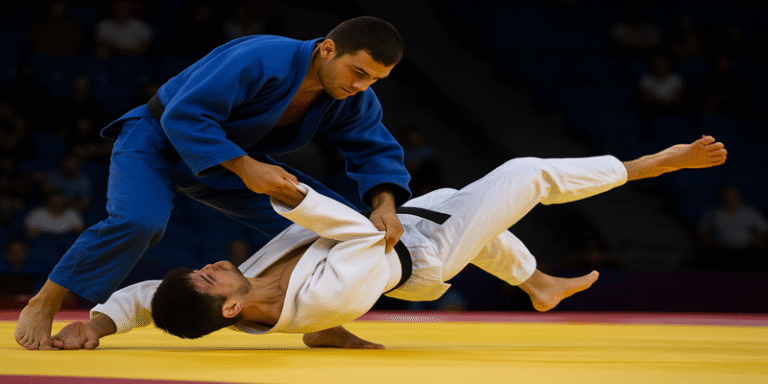OJudo, often translated as “the gentle way,” is a modern martial art and Olympic sport that originated in Japan. It combines physical prowess with a strong philosophical foundation, and today, it is practised by millions across the globe for self-defence, fitness, competition, and personal development. This article explores Judo’s rich history, guiding principles, physical and psychological benefits, competitive evolution, and its important role in education and self-defence.
History of Judo
Judo was founded in 1882 by Jigoro Kano, a Japanese educator and martial artist who sought to reform traditional jujutsu into a discipline that was both effective and morally sound. Kano established the Kodokan Judo Institute in Tokyo, which became the epicentre of Judo’s development (Kano, 1986). By removing dangerous techniques like strikes and weapon-based attacks, Kano created a safer, more accessible form of combat training that focused on throws, pins, joint locks, and strangles.
Judo quickly gained popularity in Japan and later internationally, particularly after it was included as a demonstration sport in the 1932 Los Angeles Olympics and subsequently as a full Olympic sport in 1964. Its global expansion was supported by the International Judo Federation (IJF), founded in 1951, which continues to oversee its rules and competitions (IJF, 2024).
Philosophy and Principles
Judo is not just a physical activity; it is a way of life rooted in moral and ethical development. Jigoro Kano based Judo on two core principles: Seiryoku-Zenyo (maximum efficiency with minimum effort) and Jita-Kyoei (mutual welfare and benefit) (Nakabayashi, 2002). These tenets emphasise respect, cooperation, and the intelligent use of energy. Practitioners are encouraged to cultivate discipline, humility, and empathy alongside physical skills.
Judo training integrates these values through structured etiquette, such as bowing, observing hierarchy, and maintaining respect for one’s partner and instructor. In many dojos (training halls), these rituals are considered just as important as physical technique.
Physical and Psychological Benefits
Judo is a full-body workout that develops cardiovascular endurance, muscular strength, flexibility, balance, and coordination (Franchini et al., 2011). Because it involves lifting, throwing, and controlling an opponent, it requires the practitioner to engage multiple muscle groups and improve body awareness.
Psychologically, Judo builds resilience, confidence, focus, and stress management skills. The controlled environment of randori (sparring) teaches individuals to manage pressure and react to dynamic situations. Studies have also shown that regular Judo training can lead to reduced aggression and improved emotional regulation in both children and adults (Imamura et al., 2006).
Competitive Evolution
While Judo retains its traditional roots, it has evolved significantly as a competitive sport. It was officially introduced to the Olympic Games in 1964 for men and in 1992 for women. Modern Judo competitions involve weight classes, time limits, and a points system to determine the winner, based on the execution of throws, holds, and submissions (IJF, 2024).
Over the years, the IJF has modified rules to make matches safer and more viewer-friendly. Techniques deemed too dangerous or unsportsmanlike have been restricted. For example, leg grabs were largely banned in 2010 to encourage upright posture and classical throwing techniques. These changes aim to preserve Judo’s educational value while enhancing its appeal as a spectator sport (Sterkowicz-Przybycień et al., 2017).
Judo in Physical Education and Self-Defence
Judo has been integrated into school and university curriculums in Japan and other countries as a tool for holistic development. It promotes physical fitness, discipline, and social interaction among students. Its structured belt system provides clear goals and motivates learners to progress.
As a form of self-defence, Judo is particularly practical. It teaches how to fall safely, control an attacker, and use leverage against strength. Unlike striking-based martial arts, Judo enables practitioners to neutralise threats without causing excessive harm, making it suitable for law enforcement and self-defence contexts (Harrison, 2013).
Judo is more than just a combat sport; it is a discipline that fosters physical health, mental strength, and ethical behaviour. From its origins in 19th-century Japan to its role in modern education and international competition, Judo exemplifies the union of martial skill and moral philosophy. As interest in martial arts continues to grow globally, Judo remains a compelling option for those seeking self-improvement, fitness, and community through “the gentle way.”
References
Franchini, E., Del Vecchio, F.B., Matsushigue, K.A. and Artioli, G.G., 2011. Physiological profiles of elite judo athletes. Sports Medicine, 41(2), pp.147-166.
Harrison, B., 2013. Judo as a Self-Defence System: Applied Techniques for Real-Life Situations. London: Tuttle Publishing.
Imamura, R.T., Hreljac, A., Escamilla, R.F. and Edwards, W.B., 2006. A three-dimensional analysis of the centre of mass for three different judo throwing techniques. Journal of Sports Science & Medicine, 5(CSSI), pp.122-131.
International Judo Federation (IJF), 2024. Judo Rules and Regulations. [online] Available at: https://www.ijf.org [Accessed 24 July 2025].
Kano, J., 1986. Kodokan Judo: The Essential Guide to Judo by Its Founder Jigoro Kano. Tokyo: Kodansha International.
Nakabayashi, K., 2002. Judo: Formal Techniques and Judo as Self-Defense. Tokyo: Tuttle Publishing.
Sterkowicz-Przybycień, K.L., Miarka, B., Pastwa, M. and Sterkowicz, S., 2017. Technical-tactical trends in world judo championships: A five-Olympic-cycle analysis. Journal of Human Kinetics, 56(1), pp.217-229.









